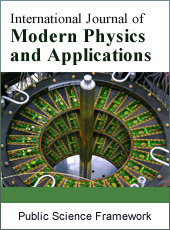International Journal of Modern Physics and Applications
Articles Information
International Journal of Modern Physics and Applications, Vol.1, No.1, Mar. 2015, Pub. Date: Mar. 26, 2015
The 10 Biggest Unsolved Problems in Physics
Pages: 12-16 Views: 12053 Downloads: 4465
[01]
Johan Hansson, Division of Physics, Luleå University of Technology, SE-971 87 Luleå, Sweden.
In 1900, the British physicist Lord Kelvin declared: “There is nothing new to discover in physics. All that remains is to more accurately measure its quantities.” In the same year quantum physics was born and three decades later it, and Einstein’s theory of relativity, had completely revolutionized and transformed physics. Today, hardly anyone would dare say that our knowledge of the universe, and everything in it, is almost complete. On the contrary, every new discovery appears to open a Pandora’s Box of larger and deeper issues. I have selected some of today’s biggest unsolved riddles in physics. Just like Moses, I stop arbitrarily at 10. Here follow these “Ten Com...plications” with a brief explanation/justification. They may be seen as a roadmap for future important work.
General Physics, Unsolved Problems
[01]
C.J. Isham, Prima Facie Questions in Quantum Gravity, Lecture given at the WE-Heraeus-Seminar “The Canonical Formalism in Classical and Quantum General Relativity”, Bad Honnef, Germany, September 1993. Based on a lecture given at the “Seminar in Memory of David Bohm”, London, May 1993; and lectures given at the UK Institute for Particle Physics, St. Andrews, Scotland, September 1993. arXiv:gr-qc/9310031.
[02]
R.N. Cahn, G. Goldhaber, The Experimental Foundations of Particle Physics, 2nd ed., Cambridge University Press (2009).
[03]
J.A. Wheeler, W.H. Zurek, Quantum Theory and Measurement, Prince- ton University Press (1983).
[04]
D. Ruelle, F. Takens, On the nature of turbulence, Comm. Math. Phys. 20, no. 3, 167 (1971).
[05]
A. Riess, et al., Observational evidence from supernovae for an accelerating universe and a cosmological constant, Astr. J. 116, 1009 (1998). arXiv:astro-ph/9805201.
[06]
S. Perlmutter, et al., Measurements of Omega and Lambda from 42 High- Redshift Supernovae, Ap. J. 517, 565 (1999). arXiv:astro-ph/9812133.
[07]
R.H. Sanders, The Dark Matter Problem: A Historical Perspective, Cambridge University Press (2014).
[08]
J. Hansson, F. Sandin, Preon stars: a new class of cosmic compact objects, Phys. Lett. B616, 1 (2005). arXiv:astro-ph/0410417; F. Sandin, J. Hansson, Observational legacy of preon stars: Probing new physics beyond the CERN LHC, Phys. Rev. D76: 125006 (2007). arXiv:astro-ph/0701768.
[09]
S. Strogatz, Sync: The Emerging Science of Spontaneous Order, Hachette Books (2003).
[10]
A.D. Sakharov, Violation of CP Invariance, C Asymmetry, and Baryon Asymmetry of the Universe, JETP Lett. 5, 24 (1967).
[11]
W. Pauli, Exclusion principle, Lorentz group and reflection of space- time and charge, p. 30, in Niels Bohr and the development of physics: Essays dedicated to Niels Bohr on the occasion of his seventieth birthday, Edited by W. Pauli with the assistance of L. Rosenfeld and V. Weisskopf, Pergamon Press (1955).
[12]
J.H. Christenson, et al., Evidence for the 2π Decay of the K 0 Meson, Phys. Rev. Lett. 13, 138 (1964).
[13]
J. Barbour, The End of Time: The Next Revolution in Physics, Oxford University Press (1999).
[14]
J. Hansson, Physical Origin of Elementary Particle Masses, EJTP 11, no. 30, 87 (2014). arXiv:1402.7033.
[15]
J. Hansson, J. Lindkvist Inhomogeneous structure formation may alleviate need for accelerating universe, Open Astron. J. 3, 145 (2010). arXiv:0906.3403.
[16]
J. Hansson, Nonlinear gauge interactions: a possible solution to the “measurement problem” in quantum mechanics, Phys. Essays 23, 237 (2010). arXiv:1001.3057.

ISSN Print: 2381-6945
ISSN Online: 2381-6953
Current Issue:
Vol. 7, Issue 1, March Submit a Manuscript Join Editorial Board Join Reviewer Team
ISSN Online: 2381-6953
Current Issue:
Vol. 7, Issue 1, March Submit a Manuscript Join Editorial Board Join Reviewer Team
| About This Journal |
| All Issues |
| Open Access |
| Indexing |
| Payment Information |
| Author Guidelines |
| Review Process |
| Publication Ethics |
| Editorial Board |
| Peer Reviewers |


